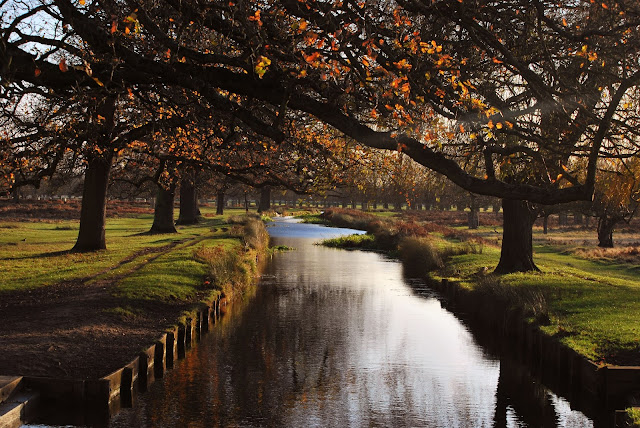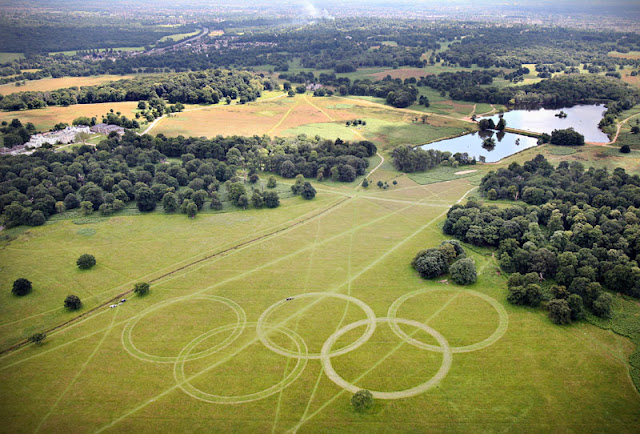The Royal Parks of London are lands originally owned by the monarchy of the United Kingdom for the recreation (mostly hunting) of the royal family but more recently, one of the biggest touring attraction in the United Kingdom. There are a total of 8 parks that cover an area of 500 acres.
Hyde Park and Kensington Gardens (which are adjacent), Green Park, Regent's Park and St James's Park are the largest green spaces in central London. Bushy Park, Greenwich Park and Richmond Park are in the suburbs. The Royal Parks agency also manages Brompton Cemetery, Grosvenor Square Gardens, Victoria Tower Gardens and the gardens of 10, 11 and 12 Downing Street. Hampton Court Park is also a royal park within Greater London, but, because it contains a palace, it is administered by the Historic Royal Palaces, unlike the eight Royal Parks.
The public does not have any legal right to use the Parks, as public access depends on the grace and favour of The Crown, although there are public rights of way across the land.A brief introduction of all these parks is given below.
Bushy Park
Bushy Park in the London Borough of Richmond upon Thames is the second largest of London's Royal Parks, at 445 hectares (1,100 acres) in area. The park, most of which is open to the public, is immediately north of Hampton Court Palace and Hampton Court Park and is a few minutes' walk from the north side of Kingston Bridge. When Henry VIII took over Hampton Court Palace from Cardinal Thomas Wolsey in 1529, the King also took over the three parks that make up modern-day Bushy Park: Hare Warren, Middle Park and Bushy Park. A keen hunter, he established them as deer-hunting grounds. The area now known as Bushy Park has been settled for at least the past 4,000 years: the earliest archaeological records that have been found on the site date back to the Bronze Age. There is also evidence that the area was used in the medieval period for agricultural purposes.
Green Park
Green Park is a park in the City of Westminster, central London. One of the Royal Parks of London, it covers 19 hectares (47 acres) between Hyde Park and St. James's Park. Together with Kensington Gardens and the gardens of Buckingham Palace, these parks form an almost unbroken stretch of open land reaching from Whitehall and Victoria station to Kensington and Notting Hill. The park is said to have originally been swampy burial ground for lepers from the nearby hospital at St James's. It was first enclosed in 16th century when it formed part of the estate of Poulteney family. In 1668 an area of the Poulteney estate known as Sandpit Field was surrendered to Charles II, who made the bulk of the land into a Royal Park as "Upper St James's Park" and enclosed it with a brick wall. He laid out the park's main walks and built an icehouse there to supply him with ice for cooling drinks in summer. By contrast with its neighbouring parks, Green Park has no lakes, no buildings and few monuments, having only the Canada Memorial by Pierre Granche, the Diana Fountain and the RAF Bomber Command Memorial. Instead the park consists almost entirely of mature trees rising out of turf; the only flowers are naturalized narcissus.
Greenwich Park
Greenwich Park is a former hunting park in Greenwich and one of the largest single green spaces in south-east London. It covers 74 hectares (180 acres) and is part of the Greenwich World Heritage Site. It commands fine views over the River Thames, the Isle of Dogs and the City of London. The estate of some 200 acres was originally owned by the Abbey of St. Peter at Ghent, but reverted to the Crown in 1427 and was given by Henry VI to his uncle Humphrey, Duke of Gloucester. He built a house by the river, Bella Court, and a small castle, called Greenwich Castle as well as Duke Humphrey’s Tower, on the hill. The former evolved first into the Tudor Palace of Placentia and then into the Queen's House and Greenwich Hospital. Greenwich Castle, by now in disrepair, was chosen for the site of the Royal Observatory by Charles II in 1675. The park stretches along a hillside and is on two levels. The lower level (closest to the Museum, Queen's House and, beyond them, the Thames) lies to the north; after a steep walk uphill, there is a flat expanse that is, essentially, an enclosed extension of the plateau of Blackheath.
Hyde Park
Hyde Park is one of the largest parks in London, and one of the Royal Parks of London, famous for its Speakers' Corner. The park was the site of the Great Exhibition of 1851, for which the Crystal Palace was designed by Joseph Paxton. The park has become a traditional location for mass demonstrations. The park is divided in two by the Serpentine and the Long Water. Hyde Park was created in 1536 by Henry VIll for hunting. He acquired the manor of Hyde from the canons of Westminster Abbey, who had held it since before the Norman Conquest; it was enclosed as a deer park and remained a private hunting ground until James I permitted limited access to gentlefolk, appointing a ranger to take charge. Charles I created the Ring (north of the present Serpentine boathouses), and in 1637 he opened the park to the general public.
Kensington Gardens
Kensington Gardens, once the private gardens of Kensington Palace, are one of the Royal Parks of London, lying immediately to the west of Hyde Park. It is shared between the City of Westminster and the Royal Borough of Kensington and Chelsea, lying within western central London. The park covers an area of 111 hectares (270 acres). The open spaces of Kensington Gardens, Hyde Park, Green Park and St. James's Park together form an almost continuous "green lung" in the heart of London between Kensington and Westminster. Kensington Gardens was originally the western section of Hyde Park, which had been created by Henry VIII in 1536 to use as a hunting ground. It was separated from the remainder of Hyde Park in 1728 at the request of Queen Caroline and designed by Henry Wise and Charles Bridgeman in order to form a landscape garden, with fashionable features including the Round Pond, formal avenues and a sunken Dutch garden.
Regent's Park
The Regent's Park is one of the Royal Parks of London. It lies within north-west London, partly in the City of Westminster and partly in the London Borough of Camden. It contains Regent's University London and the London Zoo. The park has an outer ring road called the Outer Circle (4.45 km) and an inner ring road called the Inner Circle (1 km), which surrounds the most carefully tended section of the park, Queen Mary's Gardens. Apart from two link roads between these two, the park is reserved for pedestrians. The south, east and most of the west side of the park are lined with elegant white stucco terraces of houses designed by John Nash. Running through the northern end of the park is Regent's Canal, which connects the Grand Union Canal to the former London docks. In the Middle Ages the land was part of the manor of Tyburn, the property of Barking Abbey. In the Dissolution of the Monasteries, Henry VIII appropriated the land, and it has been Crown property ever since, except for the period between 1649 and 1660.
Richmond Park
Richmond Park in south-west London was created by Charles I in the 17th century as a deer park. The largest of London's Royal Parks, it is of national and international importance for wildlife conservation. The park is a national nature reserve, a Site of Special Scientific Interest and a Special Area of Conservation and is included, at Grade I, on Historic England's Register of Historic Parks and Gardens of special historic interest in England. Its landscapes have inspired many famous artists and it has been a location for several films and TV series. Richmond Park includes many buildings of architectural or historic interest. The Grade I-listed White Lodge was formerly a royal residence and is now home to the Royal Ballet School. The park's boundary walls and ten other buildings are listed at Grade II, including Pembroke Lodge, the home of 19th-century British Prime Minister Lord John Russell and his grandson, the philosopher Bertrand Russell. Historically the preserve of the monarch, the park is now open for all to use and includes a golf course and other facilities for sport and recreation. It played an important role in both world wars and in the 1948 and 2012 Olympics.
St. James's Park
St. James's Park is a 23 hectares (57 acres) park in the City of Westminster, central London. The park lies at the southernmost tip of the St James's area, which was named after a leper hospital dedicated to St. James the Less. The park is the most easterly of a near-continuous chain of parks that also comprises (moving westward) Green Park, Hyde Park, and Kensington Gardens. In 1532, Henry VIII purchased from Eton College an area of marshland, through which the Tyburn flowed. This land lay to the West of York Place, recently acquired by Henry from Cardinal Wolsey; it was purchased in order to turn York Palace, renamed Whitehall, into a dwelling fit for a king. On James I's accession to the throne in 1603, he ordered that the park be drained and landscaped, and exotic animals kept in the park, including camels, crocodiles, and an elephant, as well as exotic birds kept in aviaries along the south. The park is bounded by Buckingham Palace to the west, The Mall to the north, Horse Guards to the east, and Birdcage Walk to the south. It meets Green Park at Queen's Gardens with the Victoria Memorial at its centre, opposite the entrance to Buckingham Palace.








No comments:
Post a Comment